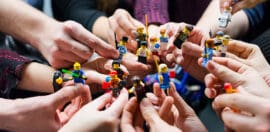Building community wealth: Are Mondragon’s cooperative ideas transferable to Australia?

Photo: Flickr
4 February 2020 at 4:46 pm
Alan Greig looks at what we can learn from the successful Mondragon model and the impact of employee ownership.
Much has been written about the phenomenal success that the Mondragon Cooperative Consortium (MCC) in Spain has been able to achieve in job creation, reducing inequality and the kind of social outcomes impact investors could only ever dream about here.
Most studies – and there have been many – reveal that the MCC thrives as a large business because (i) it is owned by its employees and (ii) it has “capped” the gap between the highest and lowest paid employee. As well, it has built a very effective and substantial social enterprise ecosystem to base and grow its operations on.
Founded 60 years ago in the Basque region of Spain, Mondragon has grown to become the world’s largest worker-owned enterprise. It is made up of a network of 260 cooperative businesses, employing 76,000 worker owners in 35 countries. It has annual revenues in excess of €12 billion (A$19.7 billion).
The salary ratio between the lowest and highest paid worker is just one to nine – quite unique when you compare this to the ratio of around one to 120 for many of the largest ASX listed companies in Australia. This approach creates a formal level of equality between all employees which supports and empowers “community wealth” to be generated within the cooperative community and invested in the creation of cooperatively-owned institutions such as technical schools, a community bank, housing and a social security system for its members.
Mondragon demonstrates that successful economic development models need not be based solely on small business start-ups and private “venture capital” investment. Economic development in the MCC works through the operation of its extensive “business network” which serves as both a local small business incubator and as solid infrastructure for ongoing service support. Its effectiveness stems from a number of innovations built into the system.
One innovation is employee ownership. Mondragon firms avoid the costs associated with providing high returns to outside investors through employee ownership. Employee ownership means that the employees have a stake in the business and they invest their ownership share and profits towards the stability and growth of the business which employs them. By itself, employee ownership can be risky, but the risk is shared broadly in the case of the MCC amongst all the employee-investors in all of the businesses in the cooperative network.
The Mondragon model suggests that the optimal size of an employee-owned firm is small to mid-sized but that the optimal size of an employee-owned “business network” can be very large indeed. While most Australians have not been oriented towards forming business networks, there are a growing number of Australian firms which are already involved in group purchasing and service supply cooperatives which do achieve economies of scale through pooling resources. The HunterNet Cooperative is one such example, operating in the Hunter region of NSW.
A community bank, owned jointly by all the member firms, is another innovation. In Mondragon’s case it has enabled members to provide “patient capital” towards local economic development, as well as to generate reciprocal support for community-owned hospitals and schools. We usually see the opposite dynamic in Australian communities where small business development programs rely mainly on government funding while bank consolidation has often made the “local bank” an endangered species.
Mondragon’s community bank (The Caja Laboral Popular), which operates like a credit union, provides financial support for regional small businesses through: (i) exploring ways to create community investment pools that are owned and governed by a broad spectrum of community stakeholders and (ii) encouraging patient “community capital” investors who can access tax deductions for making corresponding philanthropic investments to local community development funds.
The Mondragon retailing system, which integrates producers, employees, and customers as members, business partners, and co-investors, is another innovation. Local businesses can bring more of their stakeholders, including employees, customers, and local suppliers into the business. Businesses which receive regional tax concessions and other government assistance are required to share ownership rewards with the employees and the community.
Investment in community-based, jointly-owned research and education institutions is another innovation which supports startups and existing businesses towards better performance and, in some cases, global markets. Local technical schools partner with philanthropic support in providing business incubator services for students and for developing their trade skills in cooperative businesses. Economic development efforts also focus as a priority on managerial and employee education. All of these initiatives could be replicated in Australia.
One last and all-embracing innovation is the “open business organisation”. The Mondragon model decouples governance and management within business organisations through (i) broad-based ownership encompassing many stakeholders, (ii) the development of open and independent boards, and (iii) corporate senates such as “social audit councils”. The MCC’s inverted conglomerate formalises the spirit of employee empowerment. The MCC’s flexibility and economic success attest to the virtues of democracy in economic life.
For a broader discussion on the role that the Mondragon model could play in Australian regional development, see the works of the leading Australian academic in this area, Race Mathews (a former minister of the Victorian State Parliament and former long-serving secretary of the Australian Fabian Society), such as the article Mutualist Options for Regional Economic Development and Empowerment: The Mondragon and Desjardins Cases.
Employee Ownership Australia is also developing a “Community Wealth Building” framework based on the Mondragon-inspired “Employee Ownership Trust” model which operates in both the UK and the USA.
For more on the evidence of international community wealth building success through employee ownership, A Visual Guide to Employee Ownership provides the details.
About the author: Alan Greig is a board member of Employee Ownership Australia Ltd and a director of Mercury Cooperative Ltd. He is a member of the Earthworker Cooperative Consortium in Victoria which is aiming to replicate Mondragon’s approach. He is also co-ordinator of the Social Enterprise Legal Models Working Group. This paper is adapted from one originally produced some years ago by the Brisbane Institute which is no longer available online.







